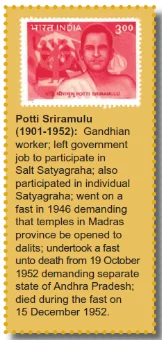![]() 26 Jul 2024
26 Jul 2024
India’s journey of state reorganization has been a complex interplay of historical, socio-political, and linguistic factors. Let us explore the journey of state reorganization in India along with its evolution, its relation with unity and diversity, and the ongoing challenges.
Formation of Provincial Congress Committees: The idea of restructuring began with the formation of provincial Congress Committees by linguistic zones following the INC’s Nagpur Session in 1920. Key figures like Lokmanya Tilak and Mahatma Gandhi supported linguistic restructuring.
Establishment: In 1948, the Constituent Assembly formed the Linguistic Provinces Commission led by Justice S.K. Dhar to investigate the desirability of linguistic provinces.

Telugu Speakers’ Demand: Telugu speakers pressured Congress to honour an earlier decision supporting linguistic states.
Establishment: After the creation of Andhra Pradesh, the Government set up the State Reorganisation Commission (SRC) in December 1953, under Justice Fazl Ali as Chairperson with K.M. Panikkar and H.N. Kunzru as members.

| Must Read | |
| Current Affairs | Editorial Analysis |
| Upsc Notes | Upsc Blogs |
| NCERT Notes | Free Main Answer Writing |
The reorganization of states in India reflects a continuous negotiation between national unity and regional aspirations. While language played a significant role, ethnicity, development, and administrative issues have also driven state formation demands. The linguistic reorganization of India largely concluded after extensive efforts, yet demands for new states based on various factors persist. These ongoing demands highlight the diverse means of uniting people beyond linguistic lines, driven by aspirations for ethnic preservation, development, and administrative efficiency.
| Related Articles | |
| REGIONALISM: UNITY, DIVERSITY, AND INCLUSIVE DEVELOPMENT | Mahatma Gandhi: The Nonviolent Force of Change |
| Functions and Legacy of the Indian Constituent Assembly | ECONOMIC DEVELOPMENT |
<div class="new-fform">
</div>